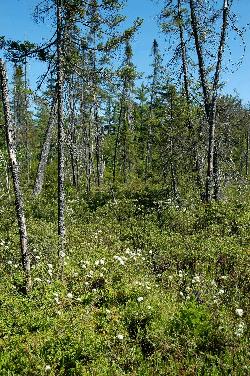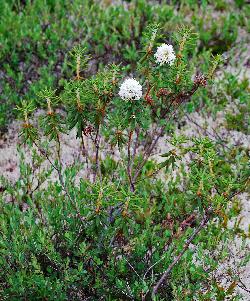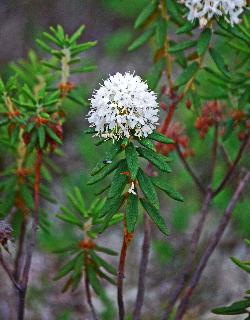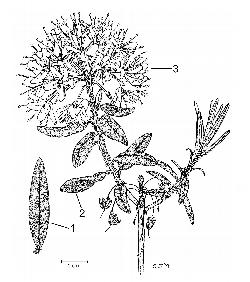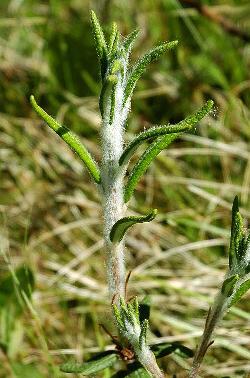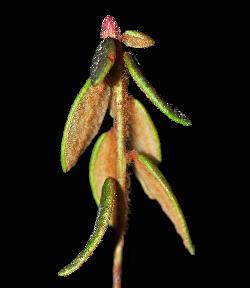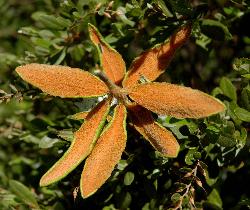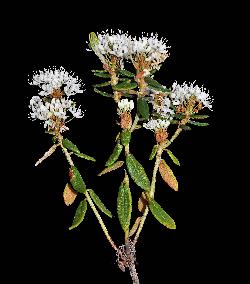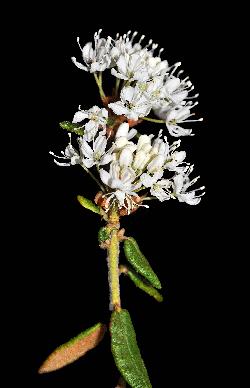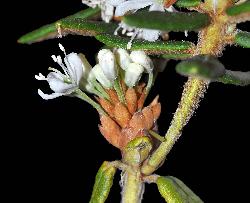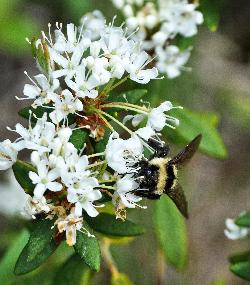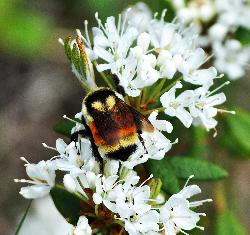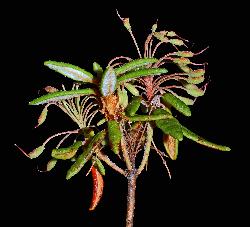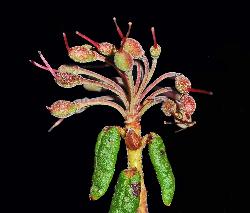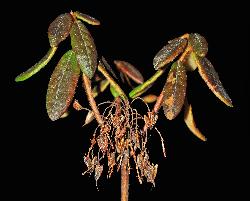Fr: thé du Labrador, lédon du Groenland, thé velouté, thé de jam (SPM)
IA: ikuta, ikutakashi, minuepaku, pinemishi
IU: mamaittuKotek, mamaittuKutet
Ericaceae - Heath Family
Note: Numbers given in square brackets in the text refer to the images presented above; image numbers are displayed to the lower left of each image.
General: A low evergreen ericaceous shrub, with erect to prostrate stems, to 1 m tall [1–3]. Although very common on open habitats, such as bogs and barrens, Labrador tea is also somewhat shade-tolerant, and commonly occurs in open-canopy forests. It can reproduce asexually by layering; it is also rhizomatous and can sprout from root crowns or rhizomes, especially after fire (Gucker 2006). Labrador tea provides cover for a variety of small mammals and birds, especially spruce grouse and ruffed grouse; its leaves are considered unpalatable by most wildlife species, but it is known to be eaten by ptarmigan (Peters 1958, Gucker 2006). Tea made from the young leaves and flowering shoots of Labrador tea is high in L-ascorbic acid (vitamin C) and has been used traditionally to treat sore throats and chest conditions, as well as other medical ailment (Porsild 1953, Moerman 2009), but Labrador tea and related species also contain a terpenoid compound, ledol, which is somewhat toxic, as well as grayanotoxins. Excessive use (more than once daily) of Labrador tea as a beverage is not recommended (Dampc and Luczkiewicz 2015).
Labrador tea, known for many years as Ledum groenlandicum Oeder, was included in the genus Rhododendron in 1990 (Judd and Kron 1990). The correct names in Rhododendron for other former Ledum species are discussed in Harmaja (1990, 1991).
Key Features: (numbers refer to the illustration [4])
- Leaves are alternate, leaf blades are leathery-textured (coriaceous), narrowly oblong-elliptic, dark green, and dull above.
- The lower surface of mature leaves has a dense layer of rusty-coloured woolly hairs, margins are revolute.
- 10–35 flowers occur in showy terminal clusters; the corolla is white and deeply 5-lobed; stamens extend well-above the corolla.
Stems/twigs: Young stems are densely pubescent (lanate) with woolly white hairs that become cinnamon-brown (ferruginous) as the stem matures [5–6]; woody twigs and branches are terete, greyish-brown to reddish-brown, and become smooth (glabrate) at maturity . The large terminal flower buds are ovoid, blunt, pinkish-red, and have several imbricate bud scales [6]; lateral buds are small, rounded, and dark brown. Leaf scars are small, hemispherical to triangular, slightly raised, and have 1 bundle trace scar.
Leaves: Alternate, simple, evergreen, pinnately-veined, and short-petiolate [6]. Leaf blades are narrowly elliptic to oblong-elliptic, leathery-textured (coriaceous), 2–5 cm long by 0.5–2.5 cm wide, and bear scattered lepidote scales on the upper surface. The upper blade surface is dark green, mainly glabrous, dull, and rugose, with slightly impressed veins; the lower surface is densely covered in matted woolly hairs (lanate) that turn from white to rusty-brown at maturity [7–8]. Leaf bases and apices are blunt (obtuse); margins are entire and revolute. During the winter, leaves turn dark brownish-green to bronze.
Flowers: Bisexual; arranged in showy umbel-like terminal inflorescences, domed or rounded at the top, with 10–35 flowers [9–10]. Pedicels are 12–25 mm long. Flower bud scales and bracts of the inflorescence bear small lepidote scales along the centre of each bud scale [11] and have fine ciliate margins. Individual flowers are about 1 cm across; the calyx is small, light green, and 5-toothed; the corolla is white with 5 ovate to oblong lobes, 5–7 mm long, which are connate only at the base [12–13]. Stamens are 5–10 and long-exserted; the compound pistil has a finely-hairy superior ovary of 5 carpels and a single prominent style that persists in fruit. Flowers blooms in early summer; pollination is by insect (entomophily). Labrador tea is self-compatible, but cross-pollination by bees improves seed set [14–15]; the most common pollinators observed in two studies were honey bees (Apis millifera L.), andrenid bees (Andrena vicina Sm.), and bumblebees (Bombus) (Reader 1975, 1977). Beetles that visit flowers of Labrador tea [16], are primarily consumers of pollen, but some pollen will be transferred accidentally in this process.
Fruit: The fruits (capsules) are ellipsoid, reddish-brown, and finely puberulent when young [17–20], but become dry and reddish-brown at maturity. The fruit is technically a septicidal capsule, which splits into 5 segments along the walls (septae) between each of the locules; dehiscence is from the base (acropetally) to the top of the capsule. Each capsule is borne on a long arching to recurving pedicel and resembles a small partially-open umbrella topped by a slender persistent style [21]. Old clusters of capsules often persist for a few years, but are exceeded by lateral branches that develop below and elongate beyond the inflorescence. The numerous seeds are small and dispersed by wind (anemochory) (Campbell et al. 2003).
Ecology and Habitat: Within the forest habitat, Labrador tea occurs in small patches, most frequently on nutrient-poor sites with dry to wet moisture regimes. It can occur in low abundance on nutrient-rich sites within poor microhabitats created by old stumps and logs. While it can survive in shade, it grows best in open forest and early seral conditions after logging and harvesting.
Edaphic Grid: See image [22]: the Edaphic Grid for Rhododendron groenlandicum.
Forest Types: Labrador tea is found with highest frequency in the following habitats:
- Alneto-Piceetum (Alder-Black Spruce Swamp Association)
- Betuletum kalmietosum (Kalmia-White Birch Subassociation)
- Caricio-Piceetum (Carex-Black Spruce Fen Association)
- Kalmio-Piceetum cladonietosum (Cladonia-Kalmia-Black Spruce Subassociation)
- Kalmio-Piceetum sphagnetosum (Sphagnum-Kalmia-Black Spruce Subassociation)
- Kalmio-Piceetum taxetosum (Taxus-Kalmia-Black Spruce Subassociation)
- Kalmio-Piceetum typicum (Kalmia-Black Spruce Subassociation)
- Osmundo-Piceetum (Osmunda-Black Spruce Fen Association)
- Piceetum marianae (Black Spruce-Moss Subassociation)
- Sphagno-Piceetum nemopanthetosum (Nemopanthus-Sphagnum-Black Spruce Subassociation)
In Labrador, Labrador tea is abundant in the Spruce-Pleurozium and Spruce-Sphagnum communities described by Foster (1984) and the Spruce/Lichen, Spruce-Fir/Dwarf Shrub, and Spruce/Sphagnum types described by Wilton (1965).
Succession: Labrador tea shows a wide range of shade tolerance; it is distinctly more abundant in open habitats compared to closed forests. Although it can survive under very dry conditions, it is much more vigorous and abundant under moist to wet conditions. Seed production and dispersal are probably most important for the long-term maintenance of populations, but vegetative sprouting from root crowns and the spread of rhizomes are thought to be most important for immediate response to disturbance by fire and cutting. On wet peaty sites, fires rarely kill the above-ground plant completely and rapid re-establishment can occur through branch sprouting. Labrador tea rhizomes occur up to depths of 20 cm, ensuring survival after most fires. Seeds of Labrador tea have a short viability in the soil, so where plants are destroyed by intense fire, recolonization occurs primarily from prolific seed production and wind dispersal from surviving plants (Gucker 2006).
Distribution: Labrador tea is a boreal to subarctic species native to North America and western Greenland; and has a transcontinental range in Canada. It occurs throughout most of Newfoundland and Labrador, extending north in Labrador to Hebron 58° 12'N (Scoggan 1978). In the United States, it occurs across the northern States, most frequently in the Border States, but is absent from Montana (USDA, NRCS 2016).
Similar Species: Our common Labrador tea is closely related to northern Labrador tea (Rhododendron tomentosum Harmaja), also known as dwarf Labrador tea or muskeg tea. Northern Labrador tea was previously known by the names Ledum palustre L. and Ledum decumbens (Aiton) Lodd. ex Steud. Northern Labrador tea can be distinguished from our common species by its smaller height, to 5 dm tall, and linear, more rugose leaves, which are up to 1.5 cm long by 1–3 mm wide; it is typically found in bogs, barrens, and tundra, rather than forested habitats.


